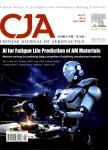Study on Compressive Properties of Z-pinned Laminates in RTD and Hygrothermal Environment
Study on Compressive Properties of Z-pinned Laminates in RTD and Hygrothermal Environment作者机构:School of Aeronautic Science and EngineeringBeihang UniversityBeijing 100191China China Electric Power Research InstituteBeijing 100192China AVIC Harbin Aircraft Industry Group Co.Ltd.Harbin 150066China
出 版 物:《Chinese Journal of Aeronautics》 (中国航空学报(英文版))
年 卷 期:2012年第25卷第1期
页 面:64-70页
核心收录:
学科分类:08[工学] 0805[工学-材料科学与工程(可授工学、理学学位)] 080502[工学-材料学] 0825[工学-航空宇航科学与技术]
基 金:National Basic Research Program of China(2011CB606105)
主 题:Z-pin laminates hygrothermal environment simulation study strength
摘 要:Compressive tests of [0]t2 and [90]t2 unidirectional laminates and [45/0/-45/90] 2s quasi-isotropic laminates are accomplished in both room-temperature and dry (RTD) and hygrothermal environment. And simulation studies on the compressive strength of Z-pinned laminates of [0112 and [45/0/-45/90] 2s are conducted by using finite element analysis (FEA). A microstructural unit cell for FEA is created to simulate a representative laminates unit with one pin. Within the unit cell, the first directions of the elements' material coordinate systems are changed to simulate the fibres' deflecting around the pin. The hygrothermal effect is simulated by the material properties' adjustments which are determined by the compressive tests of non-pined laminates. The experimental results indicate that the percentage of reduction in the compressive modulus of Z-pinned laminates caused by Z-pin becomes smaller with the percentage of 0° fibres decreasing in the laminates; the compressive strength of quasi-isotropic laminates reduces and the percentage of the reduction in the compressive strength declines with Z-pin volume content increasing, and the moisture absorption ratio of the Z-pinned specimens is greater than that of the non-pinned specimens, because the cracks around Z-pin increase the moisture absorption. In addition, the simulations show that the deflection of fibres around Z-pin is the main factor for the reduction in the compressive strength of Z-pinned unidirectional laminates, the dilution of fibre volume content caused by resin-rich pocket is the principal factor for the decline in the compressive strength of Z-pinned quasi-istropic laminates, and the compressive strength of Z-pinned specimens in hygrothermal environment reduces as the result of superimposition of some factors, including the changes in material properties caused by hygrothermal environment, the deflection of fibres and the resin-rich pocket caused by Z-pin.



